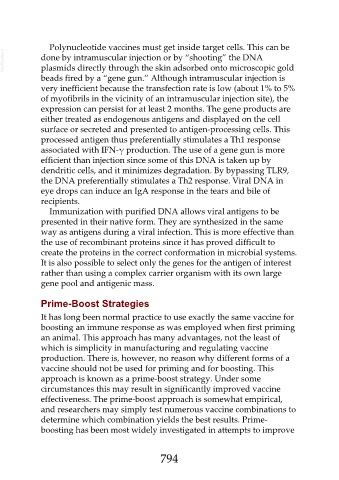Page 794 - Veterinary Immunology, 10th Edition
P. 794
Polynucleotide vaccines must get inside target cells. This can be
VetBooks.ir done by intramuscular injection or by “shooting” the DNA
plasmids directly through the skin adsorbed onto microscopic gold
beads fired by a “gene gun.” Although intramuscular injection is
very inefficient because the transfection rate is low (about 1% to 5%
of myofibrils in the vicinity of an intramuscular injection site), the
expression can persist for at least 2 months. The gene products are
either treated as endogenous antigens and displayed on the cell
surface or secreted and presented to antigen-processing cells. This
processed antigen thus preferentially stimulates a Th1 response
associated with IFN-γ production. The use of a gene gun is more
efficient than injection since some of this DNA is taken up by
dendritic cells, and it minimizes degradation. By bypassing TLR9,
the DNA preferentially stimulates a Th2 response. Viral DNA in
eye drops can induce an IgA response in the tears and bile of
recipients.
Immunization with purified DNA allows viral antigens to be
presented in their native form. They are synthesized in the same
way as antigens during a viral infection. This is more effective than
the use of recombinant proteins since it has proved difficult to
create the proteins in the correct conformation in microbial systems.
It is also possible to select only the genes for the antigen of interest
rather than using a complex carrier organism with its own large
gene pool and antigenic mass.
Prime-Boost Strategies
It has long been normal practice to use exactly the same vaccine for
boosting an immune response as was employed when first priming
an animal. This approach has many advantages, not the least of
which is simplicity in manufacturing and regulating vaccine
production. There is, however, no reason why different forms of a
vaccine should not be used for priming and for boosting. This
approach is known as a prime-boost strategy. Under some
circumstances this may result in significantly improved vaccine
effectiveness. The prime-boost approach is somewhat empirical,
and researchers may simply test numerous vaccine combinations to
determine which combination yields the best results. Prime-
boosting has been most widely investigated in attempts to improve
794

